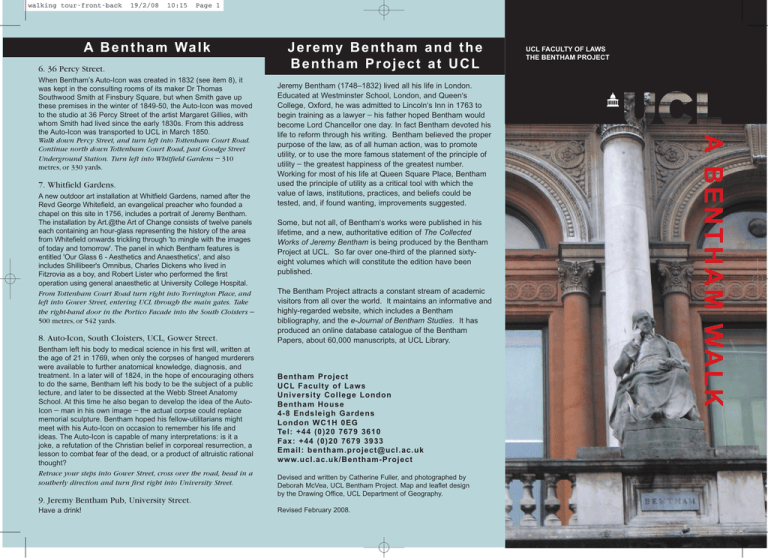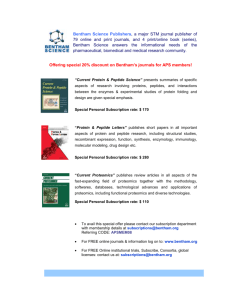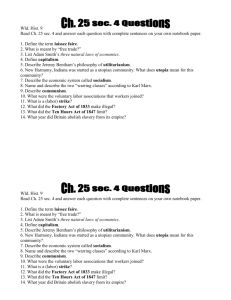6. 36 Percy Street.
advertisement

walking tour-front-back 19/2/08 10:15 Page 1 A B e n t h a m Wa l k 6. 36 Percy Street. 7. Whitfield Gardens. A new outdoor art installation at Whitfield Gardens, named after the Revd George Whitefield, an evangelical preacher who founded a chapel on this site in 1756, includes a portrait of Jeremy Bentham. The installation by Art.@the Art of Change consists of twelve panels each containing an hour-glass representing the history of the area from Whitefield onwards trickling through 'to mingle with the images of today and tomorrow'. The panel in which Bentham features is entitled 'Our Glass 6 - Aesthetics and Anaesthetics', and also includes Shillibeer's Omnibus, Charles Dickens who lived in Fitzrovia as a boy, and Robert Lister who performed the first operation using general anaesthetic at University College Hospital. From Tottenham Court Road turn right into Torrington Place, and left into Gower Street, entering UCL through the main gates. Take the right-hand door in the Portico Facade into the South Cloisters _ 500 metres, or 542 yards. 8. Auto-Icon, South Cloisters, UCL, Gower Street. Bentham left his body to medical science in his first will, written at the age of 21 in 1769, when only the corpses of hanged murderers were available to further anatomical knowledge, diagnosis, and treatment. In a later will of 1824, in the hope of encouraging others to do the same, Bentham left his body to be the subject of a public lecture, and later to be dissected at the Webb Street Anatomy School. At this time he also began to develop the idea of the AutoIcon _ man in his own image _ the actual corpse could replace memorial sculpture. Bentham hoped his fellow-utilitarians might meet with his Auto-Icon on occasion to remember his life and ideas. The Auto-Icon is capable of many interpretations: is it a joke, a refutation of the Christian belief in corporeal resurrection, a lesson to combat fear of the dead, or a product of altruistic rational thought? Retrace your steps into Gower Street, cross over the road, head in a southerly direction and turn first right into University Street. 9. Jeremy Bentham Pub, University Street. Have a drink! Jeremy Bentham (1748_1832) lived all his life in London. Educated at Westminster School, London, and Queen’s College, Oxford, he was admitted to Lincoln’s Inn in 1763 to begin training as a lawyer _ his father hoped Bentham would become Lord Chancellor one day. In fact Bentham devoted his life to reform through his writing. Bentham believed the proper purpose of the law, as of all human action, was to promote utility, or to use the more famous statement of the principle of utility _ the greatest happiness of the greatest number. Working for most of his life at Queen Square Place, Bentham used the principle of utility as a critical tool with which the value of laws, institutions, practices, and beliefs could be tested, and, if found wanting, improvements suggested. Some, but not all, of Bentham’s works were published in his lifetime, and a new, authoritative edition of The Collected Works of Jeremy Bentham is being produced by the Bentham Project at UCL. So far over one-third of the planned sixtyeight volumes which will constitute the edition have been published. The Bentham Project attracts a constant stream of academic visitors from all over the world. It maintains an informative and highly-regarded website, which includes a Bentham bibliography, and the e-Journal of Bentham Studies. It has produced an online database catalogue of the Bentham Papers, about 60,000 manuscripts, at UCL Library. Bentham Project UCL Faculty of Laws University College London Bentham House 4-8 Endsleigh Gardens London WC1H 0EG Tel: +44 (0)20 7679 3610 Fax: +44 (0)20 7679 3933 Email: bentham.project@ucl.ac.uk www.ucl.ac.uk/Bentham-Project Devised and written by Catherine Fuller, and photographed by Deborah McVea, UCL Bentham Project. Map and leaflet design by the Drawing Office, UCL Department of Geography. Revised February 2008. UCL FACULTY OF LAWS THE BENTHAM PROJECT A B E N T H A M WA L K When Bentham’s Auto-Icon was created in 1832 (see item 8), it was kept in the consulting rooms of its maker Dr Thomas Southwood Smith at Finsbury Square, but when Smith gave up these premises in the winter of 1849-50, the Auto-Icon was moved to the studio at 36 Percy Street of the artist Margaret Gillies, with whom Smith had lived since the early 1830s. From this address the Auto-Icon was transported to UCL in March 1850. Walk down Percy Street, and turn left into Tottenham Court Road. Continue north down Tottenham Court Road, past Goodge Street Underground Station. Turn left into Whitfield Gardens _ 310 metres, or 330 yards. Jeremy Bentham and the Bentham Project at UCL 19/2/08 T US ST ET RE ST ET HO . Covent Garden R M AL N' RO H LE YA RD RD . 4 CAGE G AT E TOTHILL STREET BR OA 3 2 PA R L I A M E N T T EE DEAN'S YA R D SQUARE 1 Westminster LITTLE DEAN'S YA R D School M IL LB A N K 500 T. SMITH S WESTMINSTER metres WESTMINSTER B RIDGE BRIDGE Westminster Abbey Houses of Parliament EAT GR R ST 0 Westminster 40 Queen Anne's K GateA N N E ' SW A L Queen Square Place RIA D VICTO ROA St. James's Park DS . AB RD ST K BIRD M E AR UG AL W St. James's Park E S GU BO S TH A Embankment NORT HUMB AVENU ERLAND E TEHALL HI . ST EE O LL TR D W 'S ES QU H S AN Thame s T KE AR . YM ST NT GE RE AM . J ST M LL L AL QUEEN . HA ST PA CHARING CROSS AY D STRAND Trafalgar Square DW N ROAD Leicester Square Ri ve r A RY SH BU OS S F S TE CR T AV E ET RE ST BO ST. JAMES'S St. James's Park VICTORIA EE N All buses go to Oxford Circus of Arts Buckingham Palace ING TH IIT FR LD VIGO T. S T. 5 Green Park TR Piccadilly Circus Sculpture of Royal Jeremy Bentham Academy LY IL D Green A Park C S E HO RE ST to go s ses ircu bu C ET All xford R E O T E R CHAR SO UA O PT OM ET D C RE OL ST N D N O L TO G IN T R L EE B U STR W . ST SO SQ GE O ON GT S I N EN RL RD BU GA E AY W Y UR ST RE SOHO R B MS OO L B Tottenham Court Road P ST B W RO Y RC PE ST. The walk begins in Westminster and ends at UCL, covering approximately 4 kilometres, or 2 miles. NB: If you want to see the Auto-Icon displayed at UCL the walk should be undertaken on a weekday _ Monday to Friday between the hours of 9am and 5pm. 1. Westminster School, Little Dean’s Yard. N EET bus e onto Chang 0 9 10 73 3 T E R E Oxford Circus RY BU MS OO BL STR E TT LO AR ET CH RE ST ND 6 36 Percy Street E AR British Museum AD RO 0 T 3 39 UR 10 7 T H B O N E RA COBus CE LA D AN EL ET EV E CL STR TLA ER ET U SQ M HA EN POR BLOOMSBURY GE OD GO Russell Square L EL TO MP HA UT SO ON GT IN E RR LAC TO P TT TO . ST AT R T IM D No. 32. Dentist - Samuel Cartwright P SS RU RE LD IE TF OY ZR FIT GRE TO ST RE E HI Auto-Icon South Cloisters ER W TY SI ER T IV EE UN STR Goodge T Street STREE ST AC PL 8 Jeremy Bentham W 9 Whitfield 7 Gardens TTENRHEAEMT MO N N UR COLLEGE LONDON GO Jeremy Bentham Public House Warren Street OR OXF IC A B e n t h a m Wa l k Euston E Square UNIVERSITY Pedestrian route Bus route Bus stop Great Portland Street R ON D. Page 1 OB W of 1 Sites interest 10:02 NU walking tour-inside LAMBETH BRIDGE Enter Dean’s Yard through an archway to the right of the main entrance to Westminster Abbey. Little Dean’s Yard is approached through an archway on the eastern side of Dean’s Yard. Bentham attended Westminster School from 1755, aged 7, and lodged with Mrs Morrell at 2 Little Dean’s Yard, which at the time was not a yard, but a narrow cobbled lane. Extensive work on the School and its environs began in 1785, and little of what Bentham knew is now accessible to the public. Little Dean’s Yard cannot be entered although you can stand just inside the Yard: the fourteenth century archway at the entrance, and the School Gateway directly opposite with the cobbled path leading to it, remain from Bentham’s day. He left Westminster School in the summer of 1760, and went up to Oxford in October 1760, aged 12. Cross Victoria Street, turn left into Tothill Street, and right into Queen Anne’s Gate _ 310 metres, or 330 yards. 2. Queen Square Place, Westminster. Bentham’s father, Jeremiah, moved to Queen Square Place in 1762. On the death of his father in 1792, the house at Queen Square Place became Bentham’s home until his own death in 1832. A plaque on the wall in Queen Anne’s Gate on the site of the former Home Office building records where his house once stood. Bentham’s house could be entered through a dark passageway from Queen Anne’s Gate near the site of the plaque, or through a gate into his garden from Bird Cage Walk to the left of the Barracks. Continue down Queen Anne’s Gate, and turn left. 3. 40 Queen Anne’s Gate. Bentham leased a number of properties in the area, and in 1817 William Hazlitt was his tenant at 19 York Street. Neither Queen Square Place nor York Street exist now, but James Mill and his family, including John Stuart Mill, were also tenants of Bentham from 1814 until 1831. They lived at 40 Queen Anne’s Gate, which is the only remaining domestic dwelling with which Bentham was associated in this area. Turn back into Queen Anne's Gate and turn first left into St James’s Park, cross the lake via the bridge, cross the Mall, turn left and walk towards Buckingham Palace, then turn right up Queen’s Walk on the right hand side of Green Park _ 350 metres,or 400 yards. 4. St James’s Park. Bentham was a fervent believer in a positive relationship between a healthy body and a healthy mind. In the coach house at Queen Square Place he erected a gymnasium, which included parallel bars and a trapeze, where his secretaries, and the young John Stuart Mill, took exercise. In 1825 Bentham also helped the German gymnast, Karl Voelker, to set up a gym at 28 Leicester Square. Bentham himself preferred to jog, and he variously named the activity circumgyration, ante- or post-jentacularization. In May 1822 he wrote to a correspondent in Portugal: ‘in order to be refreshed, you must do as I do in my 75th year. Every twenty four hours I spend three quarters of an hour in exercise, half walking and half running, in the two parks, St James’s Park and Hyde Park; in this way while the spirit relaxes, the body is strengthened’. From Green Park turn right into Piccadilly, cross the road and turn left into Old Bond Street, and first right into Burlington Gardens _ 1400 metres, or 1500 yards. 5. Rear entrance to the Royal Academy of Arts, Burlington Gardens. Sculpture of Bentham by Joseph Durham, 1869. The University of London was founded in 1836 to determine policy, to regulate, and to award grants to students of University College (formerly the University of London), opened in 1826, and King’s College, opened in 1831. The University of London’s first purpose-built premises in the grounds of Burlington House were opened in 1869. The facade, now the rear entrance to the Royal Academy, was decorated with twenty-two statues of eminent men, and the four statues on the portico of ‘illustrious Englishmen’ were chosen to represent the four Faculties of the University in Science, Law, Arts, and Medicine: they are Isaac Newton, Jeremy Bentham, John Milton, and William Harvey. The University of London later moved to South Kensington in 1900, and to its present building in Malet Street in 1937. Directly behind you at 32 Old Burlington Street Bentham visited his dentist, Samuel Cartwright, who, in 1823, had declared himself an admirer of Bentham’s and therefore treated him free of charge. Cartwright was also Dentist in Ordinary to George IV. EITHER continue into Vigo Street, left into Regent Street, and then right into Oxford Street, and take 10, 73 or 390 bus going in an easterly direction and alight at Percy Street. OR from Vigo Street cross Regent Street into Brewer Street which leads into Old Compton Street. Turn left into Frith Street, cross Soho Square and Oxford Street into Rathbone Place which leads into Charlotte Street, at which point turn right into Percy Street _ 1 1/2 kilometres, or just under a mile. Continued overleaf Ô




